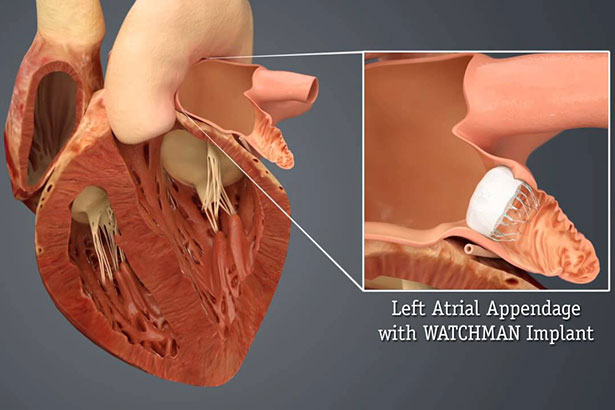The WATCHMAN implant, a minimally-invasive left atrial appendage closure (LAAC) treatment that gives patients with non-valvular AFib an alternative to long-term warfarin medication. This one-time procedure is an important option for people with a history or risk of serious bleeding on blood thinners.
What is Atrial Fibrillation?
Atrial fibrillation (Afib) is an irregular heartbeat that can lead to blood clots forming in the heart. The two upper chambers of the heart (atria) beat irregular and blood doesn’t flow like it normally does from the atria to the two lower chambers of the heart (ventricles). People can have periods of atrial fibrillation or permanent atrial fibrillation. An estimated 12.1 million people in the United States will have atrial fibrillation in 2030. Having atrial fibrillation increases your risk of stroke fivefold when compared to those who don’t have it. Patients are typically placed on anticoagulation (blood thinners) to prevent blood clots from forming that can lead to strokes.
More about Afib
How does the WATCHMAN implant work?
People with AFib are at increased risk of stroke, mainly due to blood clots that form in the left atrial appendage, a small sac in the top left chamber of the heart. Watchman is a treatment that reduces the risk of blood clots from entering the bloodstream and causing a stroke in patients with non-valvular AFib.

During the Watchman procedure, a flexible tube is guided through the veins of the leg to the left atrial appendage. When the Watchman device is deployed, it closes off the appendage and is left permanently fixed in the heart. The Watchman device does not need to be replaced and does not require open heart surgery. The procedure typically takes one and a half hours and patients recover in the hospital for 24 to 48 hours.
Is the WATCHMAN procedure right for you?
The WATCHMAN procedure is an FDA approved procedure available to patients with non-valvular (not related to a heart valve condition) atrial fibrillation who are unable to tolerate a blood thinner like Coumadin or novel oral anticoagulants or if you have a lifestyle that increases your risk of bleeding on blood thinners. This one time procedure is an alternative method to reduce stroke related to atrial fibrillation. The WATCHMAN device is inserted through the femoral vein (groin) on a catheter and is implanted in the left atrial appendage of the heart where blood clots form in patient with atrial fibrillation. The WATCHMAN device closes off this area preventing blood clots from forming and potentially leading to stroke.
All patients need a CT scan prior to the procedure to determine if their anatomy is compatible with the WATCHMAN device.
The procedure is done under general anesthesia. A special echo (transesophageal echocardiogram) is done during the procedure to guide the device in the heart. A catheter is placed in the right groin area through the vein and the device is guided up to the heart. The procedure takes about one to two hours. Post procedure, patients can expect to stay one night in the hospital for observation. There is limited down time required.
Boston Scientific: This is the WATCHMAN Implant (YouTube Video)